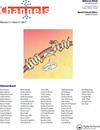EAATs中的运输和通道功能:缺失的一环
IF 3.2
3区 生物学
Q2 BIOCHEMISTRY & MOLECULAR BIOLOGY
引用次数: 1
摘要
兴奋性氨基酸转运蛋白(EAATs)是一种完整的膜蛋白,在神经传递过程中具有多种功能。它们是二级活性转运蛋白,催化谷氨酸分子和共转运离子穿过神经元和胶质细胞的质膜。这种功能对于维持谷氨酸稳态,限制谷氨酸在突触释放的扩散,防止细胞外谷氨酸过度增加至关重要,这与几种神经退行性疾病有关。此外,EAATs介导钠和亚策略依赖的阴离子选择电导。这种通道活性允许转运蛋白作为谷氨酸传感器调节细胞兴奋性,也可能通过在负电位下夹紧细胞来促进电致谷氨酸运输。这两种功能如何在同三聚体谷氨酸转运体结构中存在和交流仍然是一个悬而未决的问题。在EAATs中,底物输运和阴离子渗透被广泛认为是热力学不耦合的。然而,对谷氨酸和/或钠激活通道的要求表明,阴离子通道打开和关闭(“门控”)的转变可能在结构上与底物运输中涉及的构象变化耦合。尽管这一想法已经被一些团体所接受,但很少有直接证据表明这两个过程是如何联系在一起的。在最近发表在《生物化学杂志》上的一项研究中,我们发现了一个点突变,该突变驱动载流子处于基材和电压无关的构成开通道状态,并显示出大幅降低的底物运输活性。在这个突变体中,一个高度保守的精氨酸(EAAT1中的Arg-388)被一个带负电荷的残基取代,使底物运输减少到野生型的5%,而宏观阴离子电流幅度增加了6倍。与野生型载体相比,在表达R388D/E的细胞中测量到的这种大阴离子电导在没有钠和谷氨酸的情况下持续保持其最大活性,并且在整个电压范围内从100到C60 mV。这些观察结果表明,突变体存在于本构开放通道状态,并表明底物运输所需的一些构象变化与阴离子通道门控紧密耦合。最近,该领域的几个小组已经开始研究促进阴离子渗透的蛋白质构象状态的性质。Verdon和Boudker的晶体学数据捕获了至少一种原聚体的稳定中间构象,该构象由一个小的(~3.5 a)向内移动的输运域组成,被称为中间外向态(iOFS)。因为在这个构象中,作者观察到一个由保守的疏水残基排列的空腔,他们假设它可能提供阴离子渗透途径。基于这一观察,Shabaneh和他的同事进行了引入半胱氨酸对的交联实验。他们选择的半胱氨酸对阻止完全过渡到面向内的状态,但仍然允许向外和iOFS之间的构象转移。作者表明,这些半胱氨酸的交联消除了底物运输,而有利于本文章由计算机程序翻译,如有差异,请以英文原文为准。
Transport and channel functions in EAATs: the missing link
Excitatory Amino Acid Transporters (EAATs) are integral membrane proteins that subserve multiple functions during neurotransmission. They are secondary-active transporters that catalyze the movement of glutamate molecules along with co-transported ions across the plasma membrane of neurons and glial cells. This function is critical to maintain glutamate homeostasis, to limit the diffusion of glutamate released at synapses, and to prevent excessive increases in extracellular glutamate, which has been associated with several neurodegenerative disorders. In addition, EAATs mediate a sodiumand substratedependent anion selective conductance. This channel activity allows the transporter to serve as a glutamate sensor that regulates cell excitability and may also promote electrogenic glutamate transport by clamping the cell at negative potentials. How these 2 functions exist and communicate within the homotrimeric glutamate transporter structure remains an unanswered question. Substrate transport and anion permeation in EAATs are widely accepted to be thermodynamically uncoupled. However, the requirement for glutamate and/or sodium to activate the channel suggests that transitions involved in anion channel opening and closing (“gating”) may be structurally coupled to conformational changes involved in substrate transport. Although this idea has been entertained by several groups, little direct evidence has been provided for how the 2 processes might be linked. In a recent study published in the Journal of Biological Chemistry, we identified a point mutation that drives the carrier in a substrateand voltage-independent constitutive open channel state, and displays a substantially reduced substrate transport activity. In this mutant, substitution of a highly conserved arginine (Arg-388 in EAAT1) with a negatively charged residue decreased substrate transport to 5% of wild type, whereas the macroscopic anion current amplitude was increased six-fold. In contrast to wild-type carriers, this large anion conductance measured in cells expressing R388D/E persisted at its maximum activity in the absence of sodium and glutamate, as well as throughout the entire voltage range from ¡100 to C60 mV. These observations indicate that the mutants exist in a constitutive open channel state and suggest that some of the conformational changes required for substrate transport are tightly coupled to anion channel gating. Recently, several groups in the field have begun to examine the nature of the conformational states of the protein that facilitate anion permeation. Crystallographic data from Verdon and Boudker captured a stable intermediate conformation of at least one of the protomers, which consists of a small (~3.5 A ) inward movement of the transport domain and was termed an intermediate outward facing state (iOFS). Because in this conformation the authors observed a cavity lined by conserved hydrophobic residues, they hypothesized it may provide the anion permeation pathway. Building on this observation, Shabaneh and colleagues performed cross-linking experiments of introduced cysteine pairs. They selected cysteine pairs that prevent the full transition to inward facing states but still allow conformational shifts between the outward and iOFS. The authors showed that cross-linking of these cysteines eliminated substrate transport while favoring
求助全文
通过发布文献求助,成功后即可免费获取论文全文。
去求助
来源期刊

Channels
生物-生化与分子生物学
CiteScore
5.90
自引率
0.00%
发文量
21
审稿时长
6-12 weeks
期刊介绍:
Channels is an open access journal for all aspects of ion channel research. The journal publishes high quality papers that shed new light on ion channel and ion transporter/exchanger function, structure, biophysics, pharmacology, and regulation in health and disease.
Channels welcomes interdisciplinary approaches that address ion channel physiology in areas such as neuroscience, cardiovascular sciences, cancer research, endocrinology, and gastroenterology. Our aim is to foster communication among the ion channel and transporter communities and facilitate the advancement of the field.
 求助内容:
求助内容: 应助结果提醒方式:
应助结果提醒方式:


